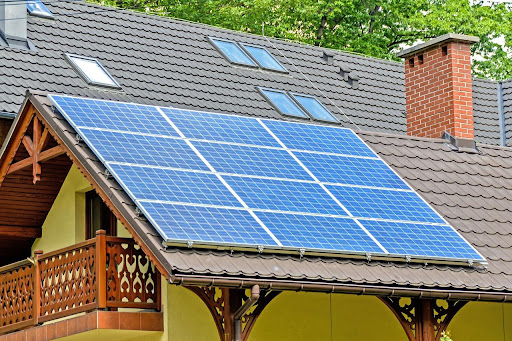6 minute read
If we used effective technology like solar panel mounting, we could harness this energy for our own usage to save money.
But there’s a bit of a learning curve to get everything up and running effectively. If you don’t read up on proper installation, your solar panels might end up being a financial burden rather than a benefit.
That’s why we’re going to give you this quick guide today to help optimize your setup so that you can get back to power your home the money-saving way with solar.
Determine Where to Place Solar Mounting Brackets
When determining the placement of solar mounting brackets, it is important to consider multiple factors. First, the solar panel needs to be positioned in an area that will provide the most direct sunlight.
This is usually on a south-facing roof, but east and west-facing roofs can also work. The location should also be free of shade from nearby trees or structures and should be accessible for regular maintenance.
Additionally, the solar panel needs to be mounted securely to avoid damage from high winds, which could cause a shift in the mounting brackets.
Finally, the mounting brackets should be able to accommodate any infrastructure, such as piping or air-conditioners, so that the panels are not disturbed in the process. By considering all these factors, you can properly determine the best place to install solar mounting brackets.
Thermoseal and Secure the Mounting Brackets
Thermoseal and Secure the Mounting Brackets are an important part of solar panel mounting installation. This step requires a high-quality sealant to ensure the mounting brackets are firmly secured to the surface.
The sealant should be applied evenly to all edges of the mounting bracket and onto the surface. It also should be applied to the wall or roof so the mounting bracket is firmly secured. Specialized sealants, such as thermoplastic or silicone, are recommended for extreme conditions to ensure weatherproof protection.
The adhesive should also be applied consistently to ensure the mount is structurally sound and secure. Once complete, the mounting brackets should be checked for strength and durability against extreme weather conditions.
Measure and Set Up Rails
Measuring and setting up rails for solar panel mounting installation is an important part of the installation process. Proper measurement and setup of the rails will ensure the solar panel is mounted securely and efficiently for maximum power output.
Measuring the distance between the mounting structure and the solar panel should be done to ensure the rails are the correct length. Once the measurement is taken, the rails should be cut to size.
After that, each rail should be secured to the mounting structure with lag screws and washers, which should be spaced approximately 7-8 inches apart every 6-8 inches along the rail. Once secured, the panels can be fully installed and ready to generate electricity.
Set Up Your Power System and Connect Panels
Solar panel mounting installation is important for setting up and connecting various solar panel systems. It consists of components that are necessary for mounting and connecting the panels securely and safely to a roof or other surface area.
This includes hardware such as support brackets, base rails, u-bolts, nuts, washers, fasteners, and tools for connecting the panels and finishing off the installation. Solar panel mounting and installation should be done by a qualified professional in order to ensure proper installation.
Additionally, all safety guidelines should be followed during installation to minimize the risk of injury and damage to the solar panel and installation area.
Following the steps outlined in the instruction manual and connecting the panels correctly is essential for starting and powering your system properly. Feel confident and assured knowing your installation will be in good hands with trusted and knowledgeable professionals.
Install Solar Panels
Solar panel mounting installation is crucial for any successful solar panel installation. It is important to make sure that the solar panel installation chosen is the best and most efficient option for the particular location.
Online resources, as well as professional guidance, can be used to assess your particular home or site. Solar panel mounting installation involves many steps, such as carefully analyzing the azimuth and elevation for the space, choosing an appropriate racking system, orienting the solar panels, and properly securing the panels for maximum efficiency.
Properly mounting solar panels is an incredibly important step in installing solar panels. It is necessary that this step is done correctly in order to ensure the highest efficiency and safety of the system.
It is recommended to hire a professional solar installer to guarantee the project is done correctly and safely. With a professional installer, a customer can be ensured that their solar system will be installed correctly and will be ready to generate power in no time.
How to Adjust Panels for Different Roof Types
Solar panel mounting installation is an important step in the photovoltaic process and can vary based on the type of roof that is being used. Adjusting panels for different roof types can involve numerous steps, such as attaching mounting rails to the roof, tightening screws, and positioning the panels to ensure the best possible angle of the sun’s rays.
On sloped roofs, such as shingled ones, the angle of the panels should be adjusted to match the angle of the roof as closely as possible in order to maximize its solar power harvesting efficiency.
On flat roofs, the panels should be adjusted to meet local building codes and should be secure enough to withstand weather conditions. On metal roofs, mounting rails should be used, and screws should be secured to the ribs of the roof to ensure long-term stability.
Finally, particular attention should be given to ensuring that the rooftop solar panels are properly insulated and waterproofed to prevent future damage. Check this link to learn more about solar panel installation.
Read More About Solar Panel Mounting
Solar panel mounting is an important factor when it comes to solar installation. It ensures that panels are mounted securely and safely during any type of weather.
With this comprehensive homeowner’s guide, you can confidently install your solar panel mountings and create a more energy-efficient home.
Did you find this article helpful? Check out the rest of our blog for more!






